A core part of the Canadian Domestic Homicide Prevention Initiative with Vulnerable Populations (CDHPIVP) is knowledge mobilization. Over the course of the five-year SSHRC funded project, project updates and research findings will be shared through various platforms such as conferences and webinars, online training modules, public education campaigns, social media platforms, and e-bulletins and newsletters.
Resources, newsletters, and recorded webinars produced as part of the CDHPVIP will be posted here as they become available.
You can also visit "Resources & Initiatives" in the menu bar to learn more about Canadian Initiatives related to domestic homicide prevention and about domestic violence death review committees.
- Annotated Bibliographies
- Advice from Survivors
- Domestic Homicide Briefs
- Fact Sheets
- Literature Review
- Newsletters
- Reports
- Research Protocol
- Journal Articles
- Theses
- Infographics
- Posters
Annotated Bibliographies
The CDHPIVP conducted a literature review to synthesize research and resources on risk assessment, risk management and safety planning related to incidences of repeat or lethal domestic violence (DV) among Indigenous populations; rural, remote and Northern communities; immigrant and refugee populations; and children exposed to domestic violence. The review was international in scope and included both academic and grey literature published between January 1, 2000 and December 31, 2015. The literature review was comprehensive; however, there may be resources missed due to the particular search parameters used in the review (e.g., search terms used, research databases reviewed). Below are the annotated bibliographies for the literature reviewed. The annotated bibliographies outline the key pieces of information including the research purpose, theoretical framework, methods, findings, and any recommendations related to risk assessment, risk management, and/or safety planning. The annotated bibliographies are organized based on the population they pertain to (i.e., Indigenous; rural, remote and Northern; immigrant and refugee; children exposed to DV; or general population) with overlapping articles included in all relevant annotated bibliographies (e.g., Indigenous and Rural, Remote, and Northern).
Domestic Homicide Briefs
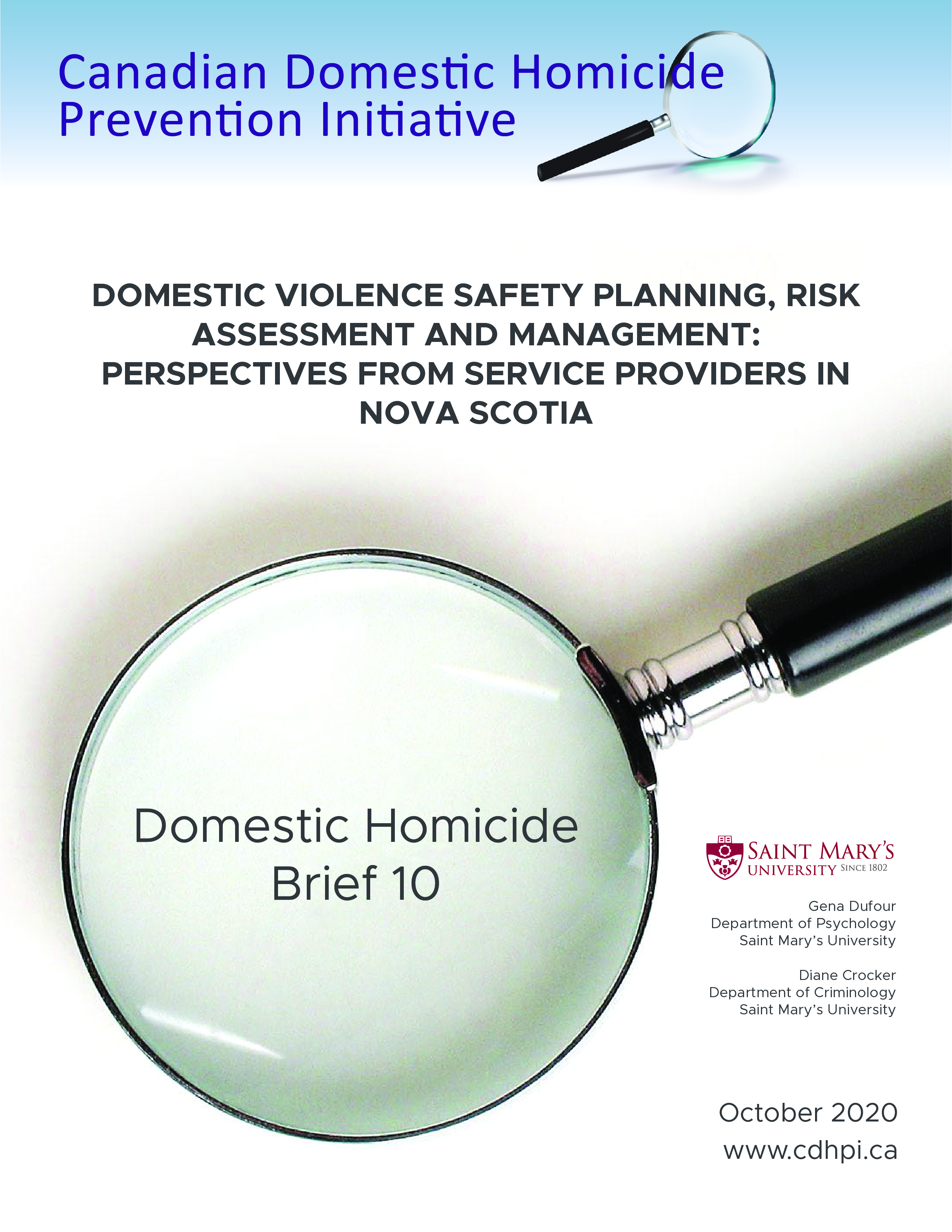 Brief 10: Domestic Violence Safety Planning, Risk Assessment And Management: Perspectives From Service Providers In Nova Scotia
Brief 10: Domestic Violence Safety Planning, Risk Assessment And Management: Perspectives From Service Providers In Nova Scotia
Brief 9: Familicide in Canada : 2010-2019
The Canadian Domestic Homicide Prevention Initiative with Vulnerable Populations presents its ninth Homicide Brief, Familicide in Canada: 2010-2019. This brief offers a summary of data collected through the Canadian Domestic Homicide Prevention Initiative with Vulnerable Populations focusing on familicide – the killing of multiple family members. Families living in rural, remote and northern populations appear to be particularly vulnerable offering implications for risk assessment, risk management and safety planning.
- View plaintext webpage version
- View Printable PDF version
- En français: Le Familicide au Canada : 2010-2019
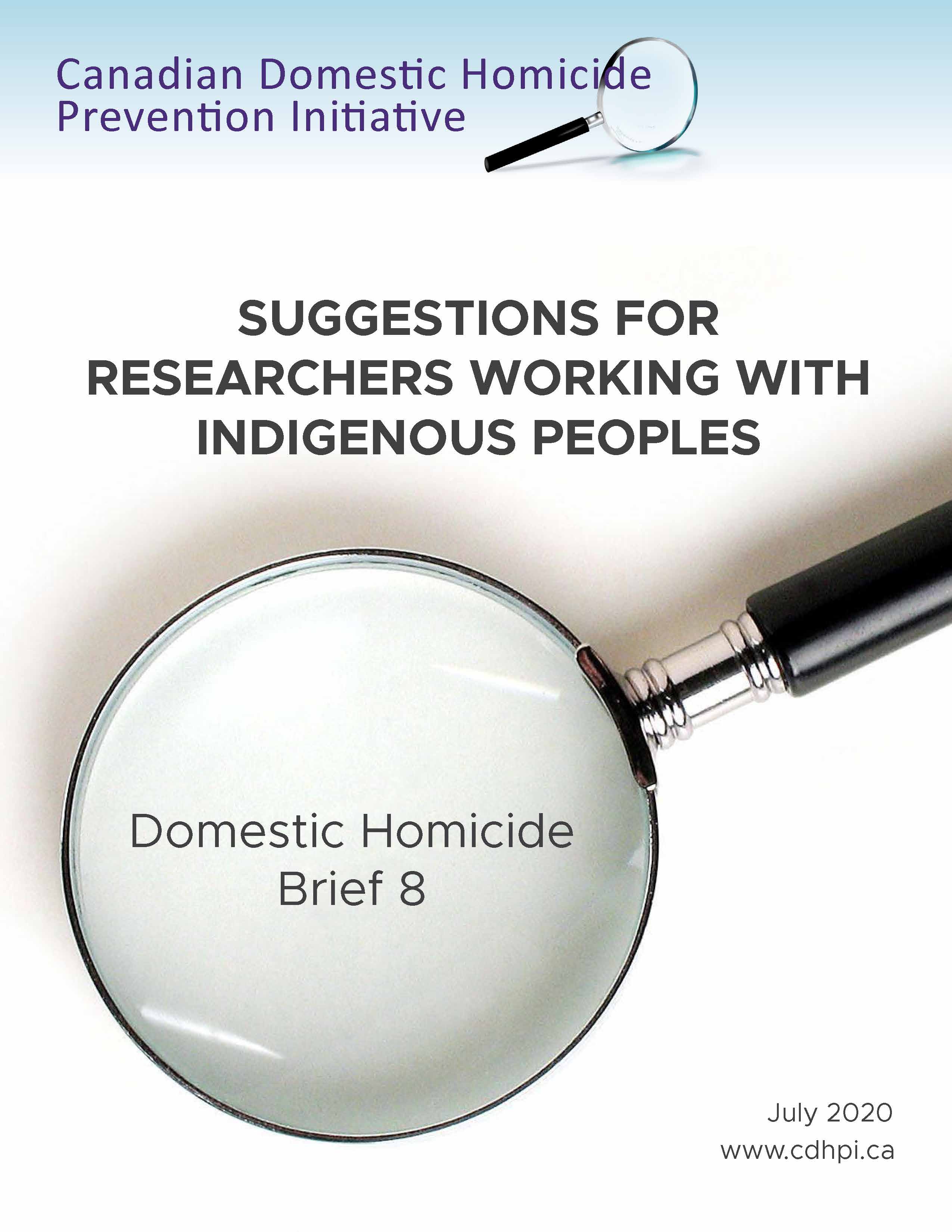 Brief 8: Suggestions for Researchers Working with Indigenous Peoples
Brief 8: Suggestions for Researchers Working with Indigenous Peoples
The Canadian Domestic Homicide Prevention Initiative with Vulnerable Populations presents its eighth brief, “Suggestions for researchers working with Indigenous peoples.” Within this brief, Cathy Richardson identifies and dispels myths about Indigenous people, and provides context for how to work collaboratively with Indigenous people when conducting research instead of making Indigenous people the topic of research.
- View plaintext webpage version
-
View Printable PDF version
En français: Suggestions pour les chercheurs qui travaillent avec les populations Autochtones
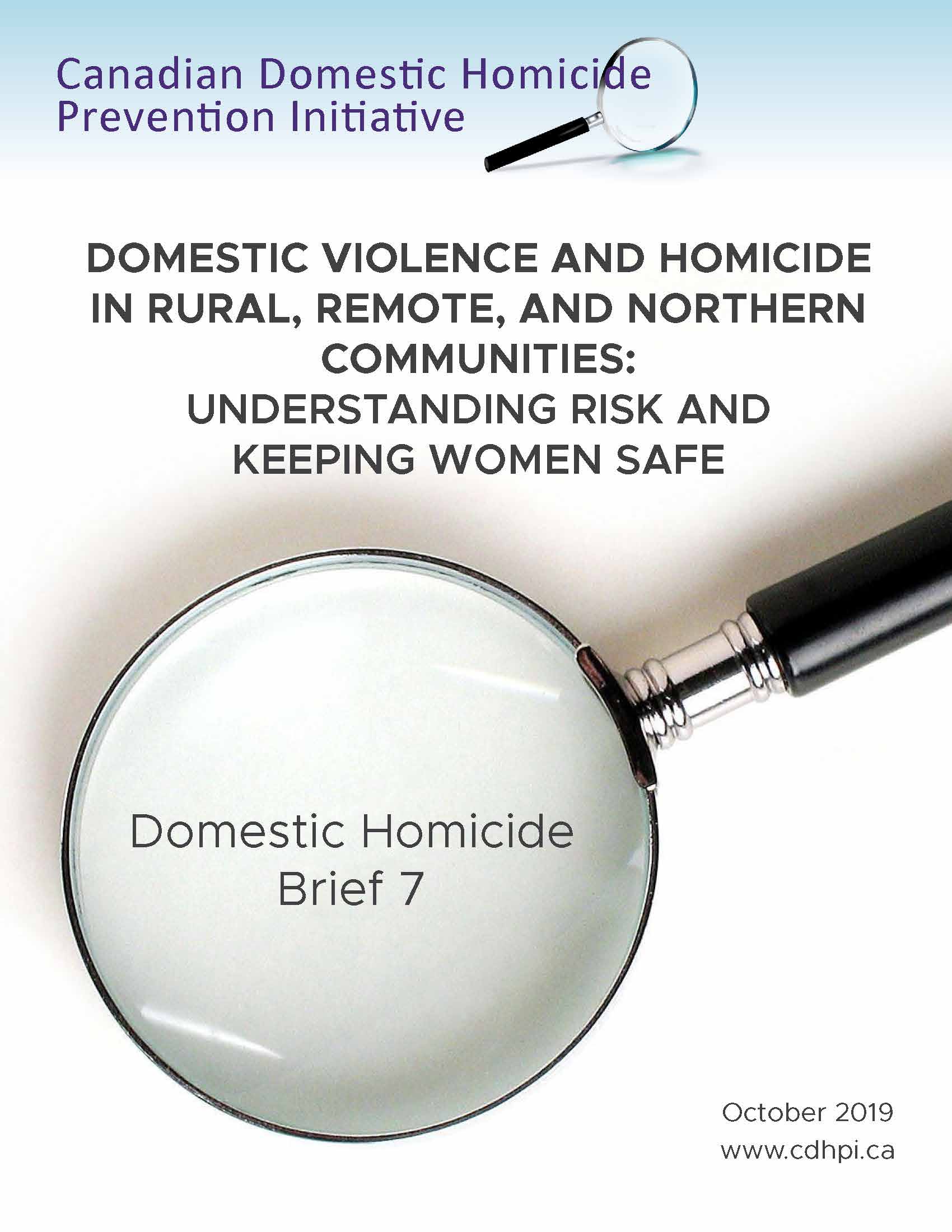 Brief 7: Domestic Violence and Homicide in Rural, Remote, and Northern Communities: Understanding Risk and Keeping Women Safe
Brief 7: Domestic Violence and Homicide in Rural, Remote, and Northern Communities: Understanding Risk and Keeping Women Safe
Domestic Violence and Homicide in Rural, Remote, and Northern Communities: Understanding Risk and Keeping Women Safe is the seventh brief in the Homicide Brief series developed by the Canadian Domestic Homicide Prevention Initiative with Vulnerable Populations (CDHPIVP). This brief dentifies risk factors for domestic violence and homicide that appear to be more prevalent or have more significance for women living in rural, remote and northern communities in Canada. Current research and promising practices are highlighted for domestic violence risk assessment, risk management, and safety planning.
- View plaintext webpage version
- View Printable PDF version
- En français : Violence et homicides familiaux dans les collectivités rurales, éloignées et nordiques : Comprendre le risque et assurer la sécurité des femmes (Traduction: Agnès Revenu)
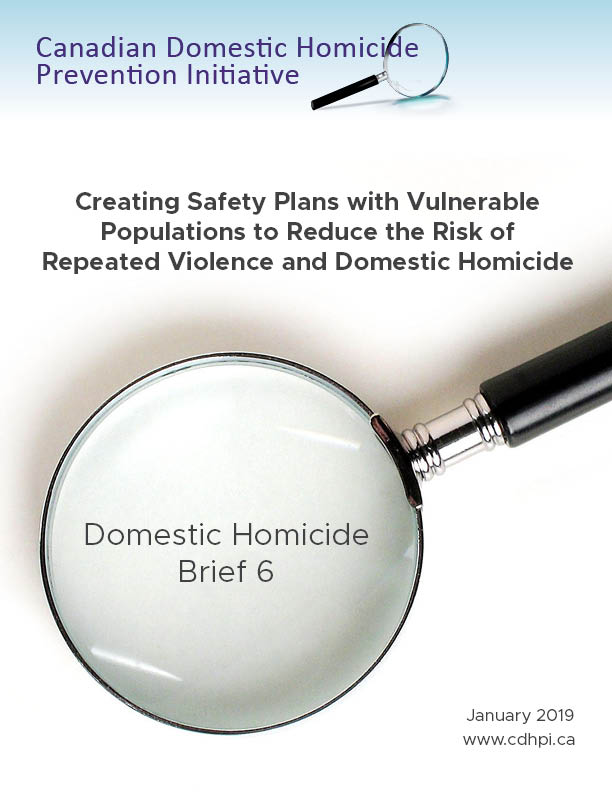 Brief 6: Creating Safety Plans with Vulnerable Populations to Reduce the Risk of Repeated Violence and Domestic Homicide
Brief 6: Creating Safety Plans with Vulnerable Populations to Reduce the Risk of Repeated Violence and Domestic Homicide
The Canadian Domestic Homicide Prevention Initiative with Vulnerable Populations presents its sixth Learning Brief, Creating Safety Plans with Vulnerable Populations to Reduce the Risk of Repeated Violence and Domestic Homicide. Within this Brief, safety planning strategies are defined and the importance of protecting women and those close to them by creating a safety plan is discussed. Safety planning with vulnerable populations is discussed in detail including common challenges, promising practices, and emerging issues. Safety planning tools and resources are provided.
- View plaintext webpage version
- View Printable PDF version
- En français : Établir des plans de sécurité avec les populations vulnérables pour réduire le risque de violence répétée et d’homicide familial familiaux (Traduction: Agnès Revenu)
Brief 5: Domestic Violence Risk As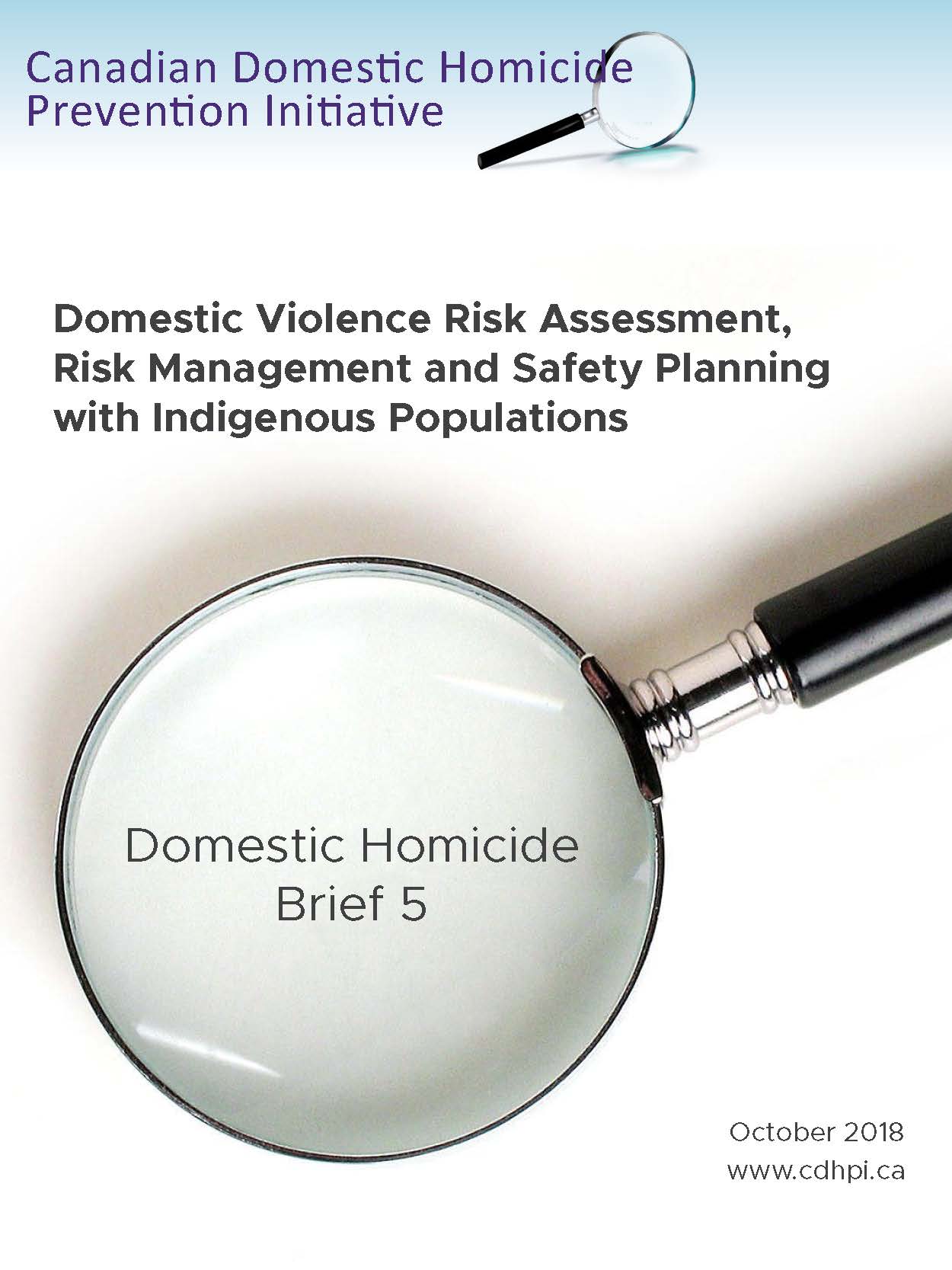 sessment, Risk Management and Safety Planning with Indigenous Populations
sessment, Risk Management and Safety Planning with Indigenous Populations
Domestic Violence Risk Assessment, Risk Management and Safety Planning with Indigenous Populations (fifth in a series developed by the Canadian Domestic Homicide Prevention Initiative with Vulnerable Populations) discusses the historical injustices of Canadian Indigenous peoples such as colonization, residential schools, and the ‘sixties scoop’ as well as the ongoing injustices and discrimination that Indigenous peoples currently face that put Indigenous women at greater risk of experiencing domestic violence or homicide. Current research and promising practices are highlighted for domestic violence risk assessment, risk management, and safety planning with Indigenous families.
- View plaintext webpage version
- View Printable PDF version
- En français : Violence familiale : Évaluation de risque, gestion de risque et planification de la sécurité au sein des populations autochtones (Traduction: Agnès Revenu)
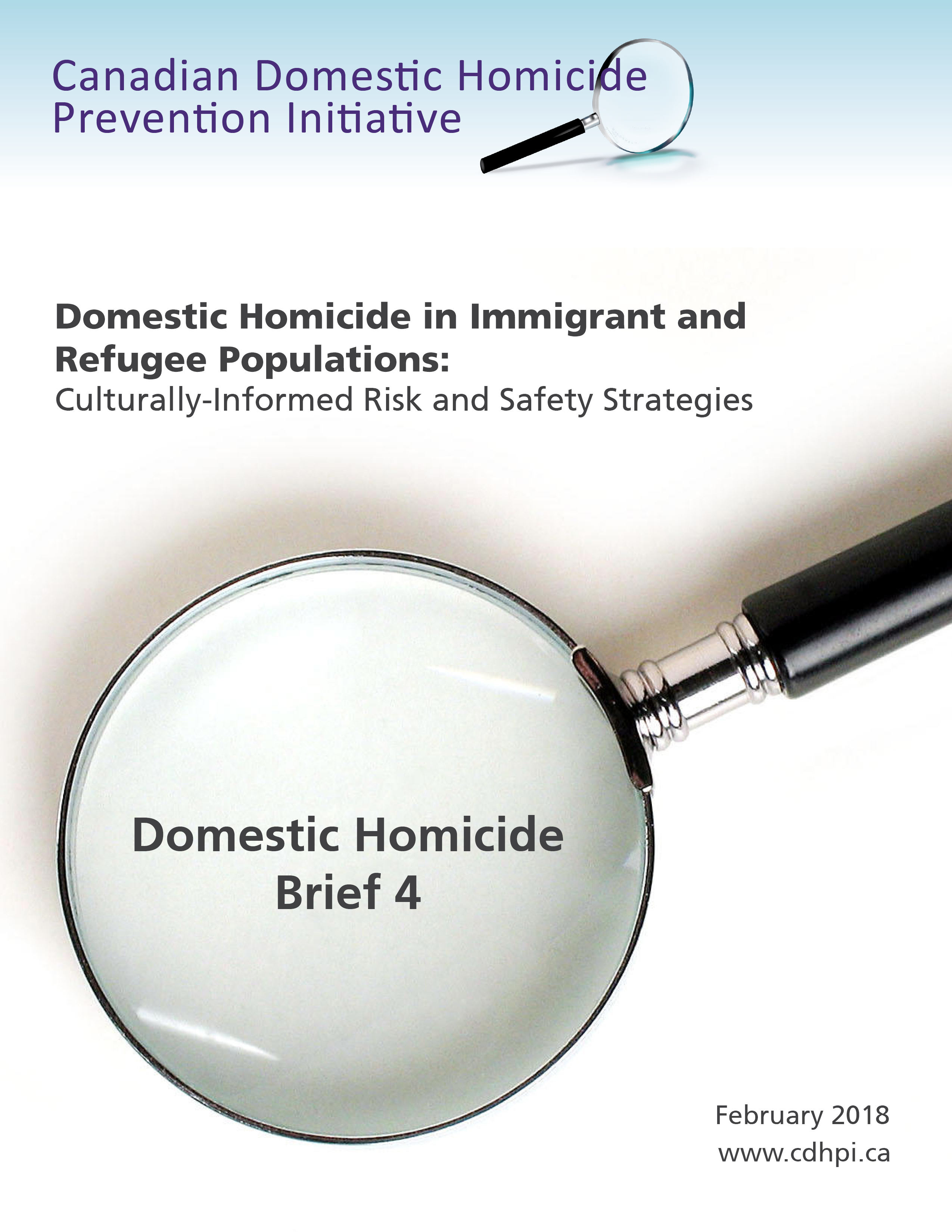 Brief 4: Domestic Violence in Immigrant and Refugee Populations: Culturally Informed Risk and Safety Strategies
Brief 4: Domestic Violence in Immigrant and Refugee Populations: Culturally Informed Risk and Safety Strategies
This brief is the fourth in the series developed by the Canadian Domestic Homicide Prevention Initiative with Vulnerable Populations (CDHPIVP). The Brief provides definitions, describes the context and unique risk factors for domestic homicide within immigrant and refugee populations, and highlights culturally-informed and culturally-specific domestic violence risk assessment, risk management, and safety planning strategies to respond to, and prevent, potentially lethal domestic violence. National community-based research and resources are highlighted.
- View plaintext webpage version
- View Printable PDF version
- En français : Les homicides familiaux au sein des populations immigrantes et réfugiées : Risques et stratégies de sécurité tenant compte du contexte culturel (Traduction: Agnès Revenu)
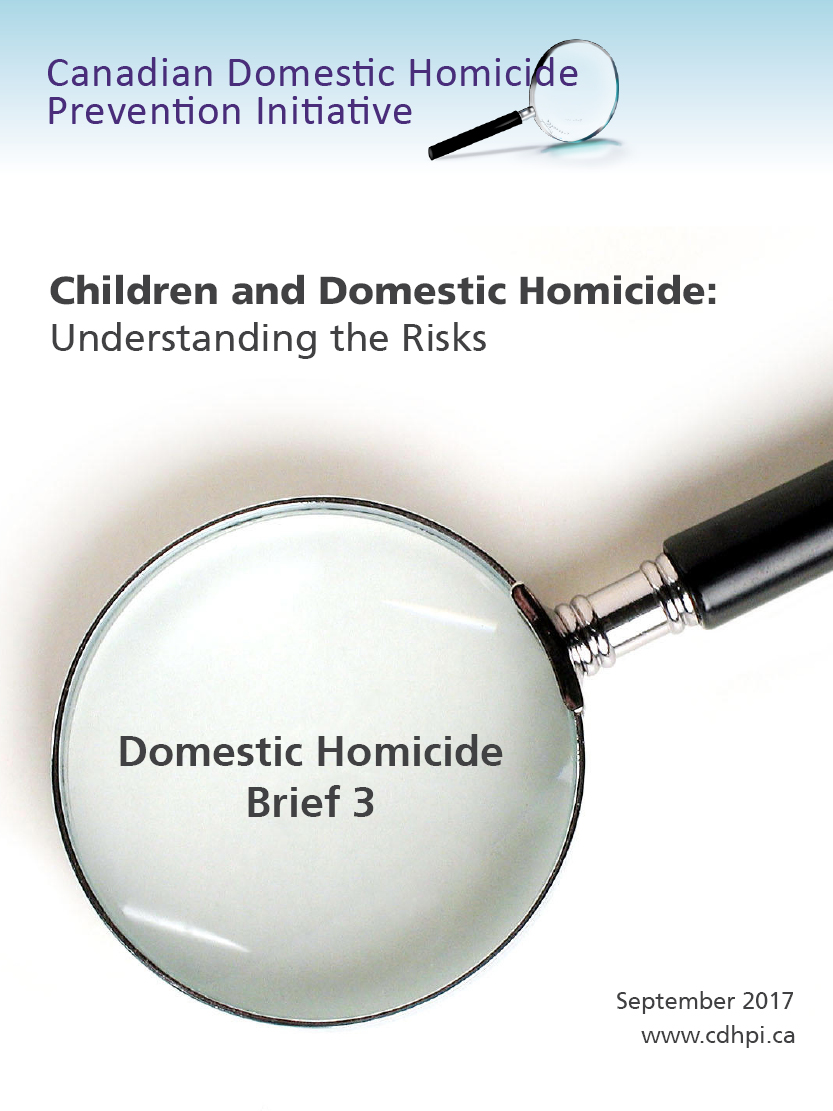 Brief 3: Children and Domestic Homicide: Understanding the Risks
Brief 3: Children and Domestic Homicide: Understanding the Risks
This is the third in the series developed by the Canadian Domestic Homicide Prevention Initiative with Vulnerable Populations (CDHPIVP). The Brief highlights risk assessment, risk management, and safety planning for children exposed to domestic violence (DV) and at risk of lethality. The Brief provides a definition of child domestic homicide and identifies specific risk factors for children killed in the context of DV. The unique role of professionals working with children exposed to DV is highlighted. The Brief illustrates four cases of child domestic homicide that occurred across the country to highlight the importance of conducting risk assessment, risk management, and safety planning with children living with DV. Finally, the Brief looks at how child domestic homicides can be prevented through risk assessment, risk management, and safety planning and illustrates the importance of using an intersectional lens when helping children exposed to DV. Future directions in how to narrow the gap between knowledge and practice are discussed.
- View plaintext webpage version
- View Printable PDF version
-
En français : Les enfants et les homicides familiaux : Comprendre les risques (Traduction: Agnès Revenu)
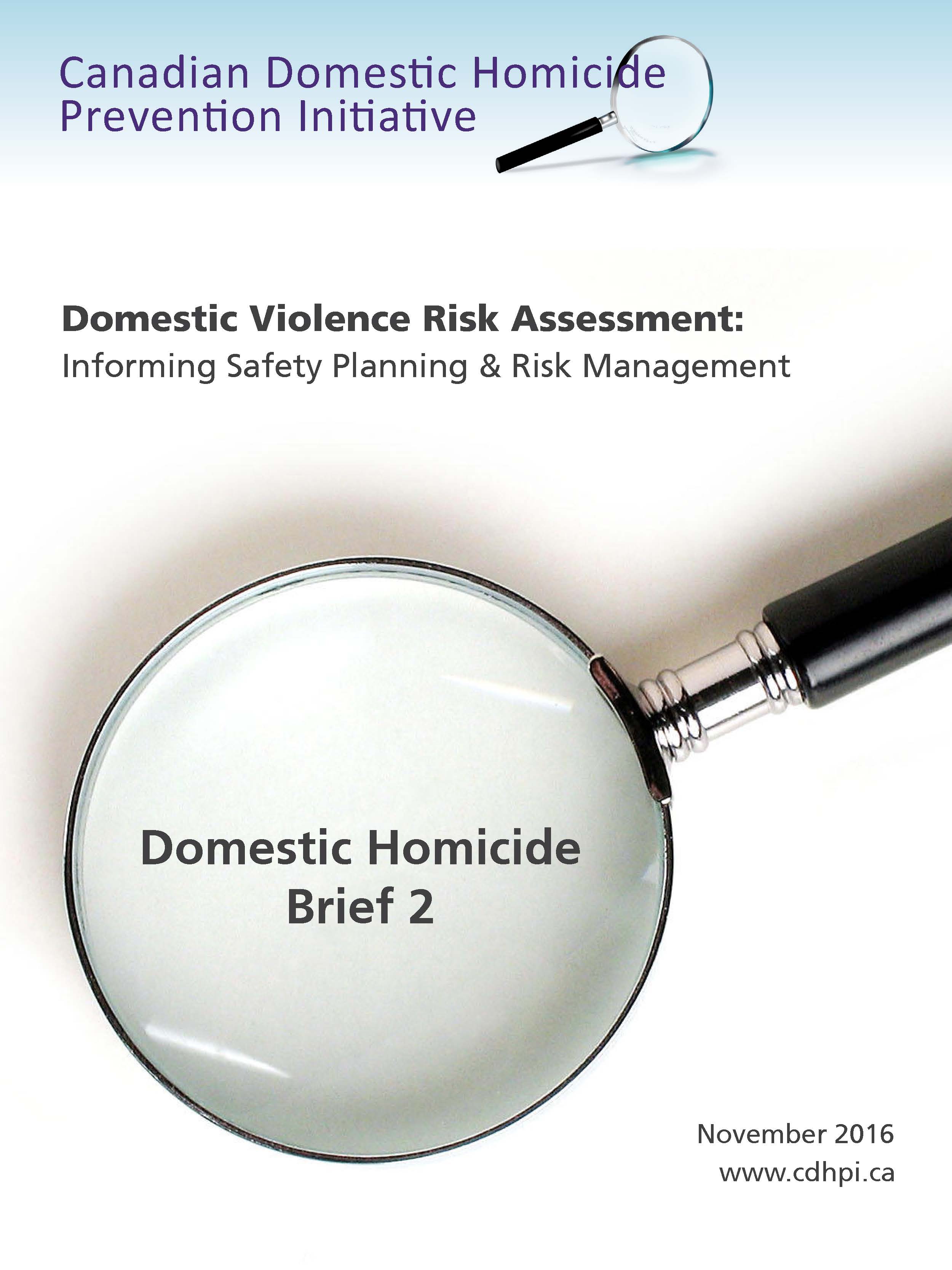 Brief 2: Domestic Violence Risk Assessment: Informing Safety Planning & Risk Management
Brief 2: Domestic Violence Risk Assessment: Informing Safety Planning & Risk Management
This is the second Brief in the Domestic Homicide series of the Canadian Domestic Homicide Prevention Initiative with Vulnerable Populations (CDHPIVP). This Brief describes domestic violence risk assessment including the reasons for conducting assessments, the nature and kind of risk assessment tools, best practice in domestic violence risk assessment, predictive validity of tools, and the importance of victims’ perceptions of risk. The Brief indicates how domestic violence risk assessment informs risk management with offenders and safety planning with victims/survivors. Finally, the Brief outlines domestic violence risk assessment with particular vulnerable populations.
- View plaintext webpage version
- View Printable PDF version
- En français : L’évaluation des risques de violence familiale : Pour mieux orienter la planification de la sécurité et la gestion des risques (Traduction: Agnès Revenu)
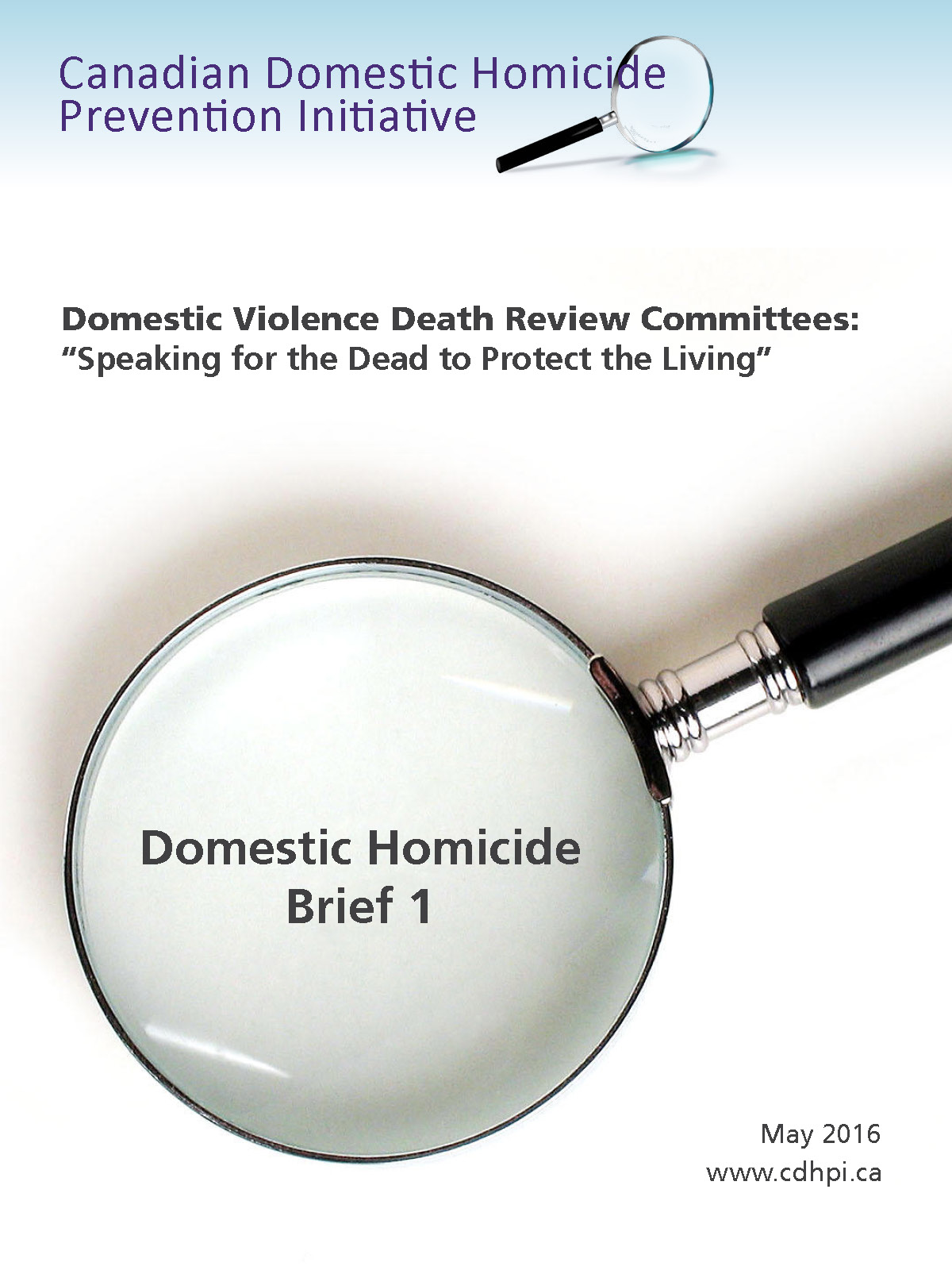 Brief 1: Domestic Violence Death Review Committees: "Speaking for the Dead to Protect the Living"
Brief 1: Domestic Violence Death Review Committees: "Speaking for the Dead to Protect the Living"
This Domestic Homicide Brief is the first in a series developed by the Canadian Domestic Homicide Prevention Initiative with Vulnerable Populations (CDHPIVP). The CDHPIVP is a national research project on domestic homicide in Canada specifically focusing on identifying unique risk factors and prevention strategies within particular vulnerable groups (children exposed to domestic violence; rural, remote and Northern communities; immigrant and refugee populations; and Indigenous peoples). The Domestic Homicide series discusses topics relevant to the CDHPIVP research with Brief #1 highlighting and describing domestic violence death review committees. Please review and provide feedback through the evaluation link.
- View plaintext webpage version
- View Printable PDF version
- En français : Comités d’examen des décès dus à la violence familiale : « Nous parlons pour les morts afin de protéger les vivants » (Traduction: Agnès Revenu)
Fact Sheets
Fact Sheet #1: Domestic Homicide in Canada
Literature Review
This literature review has identified vulnerabilities for domestic homicide within four specific populations: Indigenous peoples; immigrants and refugees; rural, remote, and northern communities; and children exposed to domestic violence. Although each population can have distinct vulnerabilities for domestic homicide, these populations also share common risk factors for experiencing domestic violence and homicide. To address these vulnerabilities and risks, the literature recommends that risk assessment, risk management, and safety planning be culturally or context appropriate; consider the sociocultural and historical aspects of risk; and involve service/sector coordination and collaboration. Overall, the literature identified a need for differentiated, social, and intersectional approaches to domestic violence and homicide research and practice.
View webpage
Newsletters
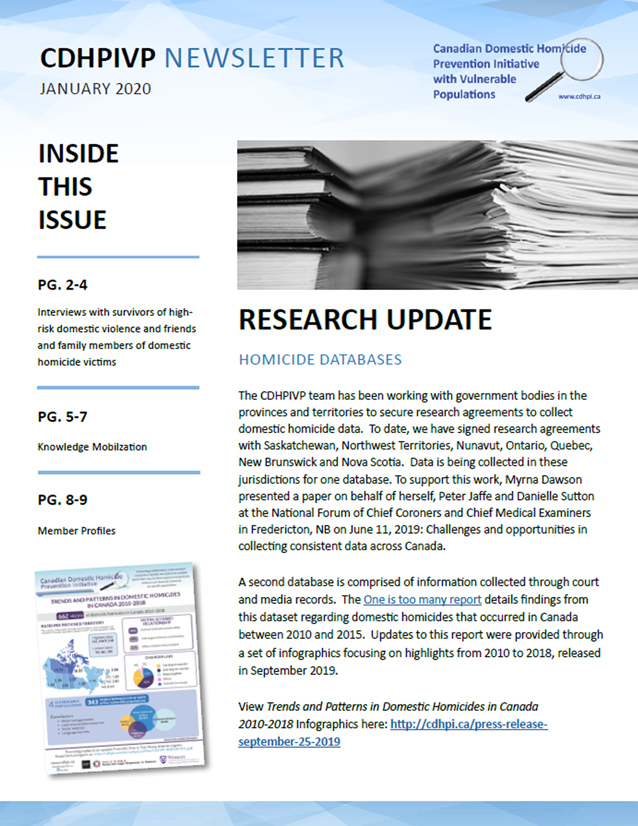 Volume 4, Issue 1 - Winter 2020
Volume 4, Issue 1 - Winter 2020
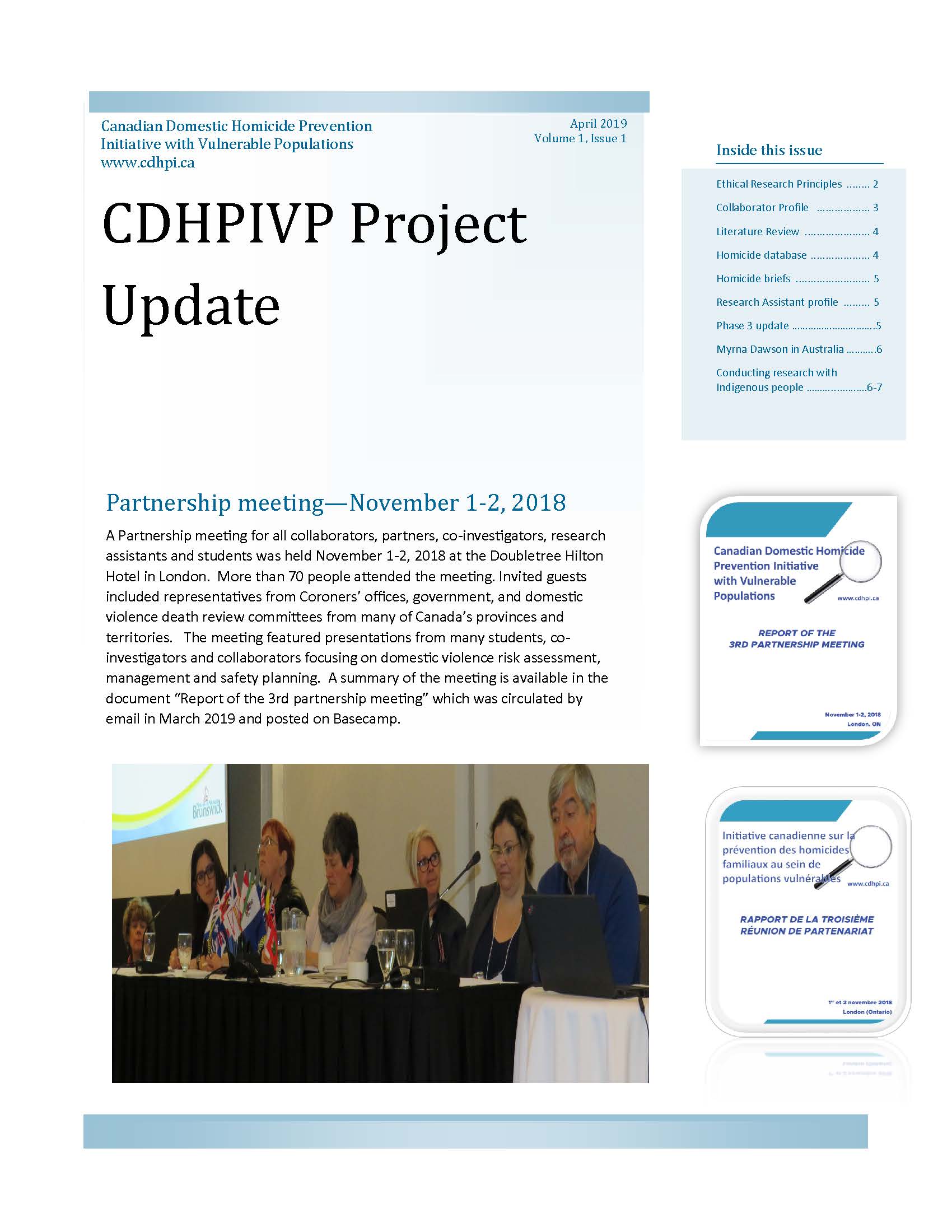 Volume 3, Issue 2 - Spring 2019
Volume 3, Issue 2 - Spring 2019
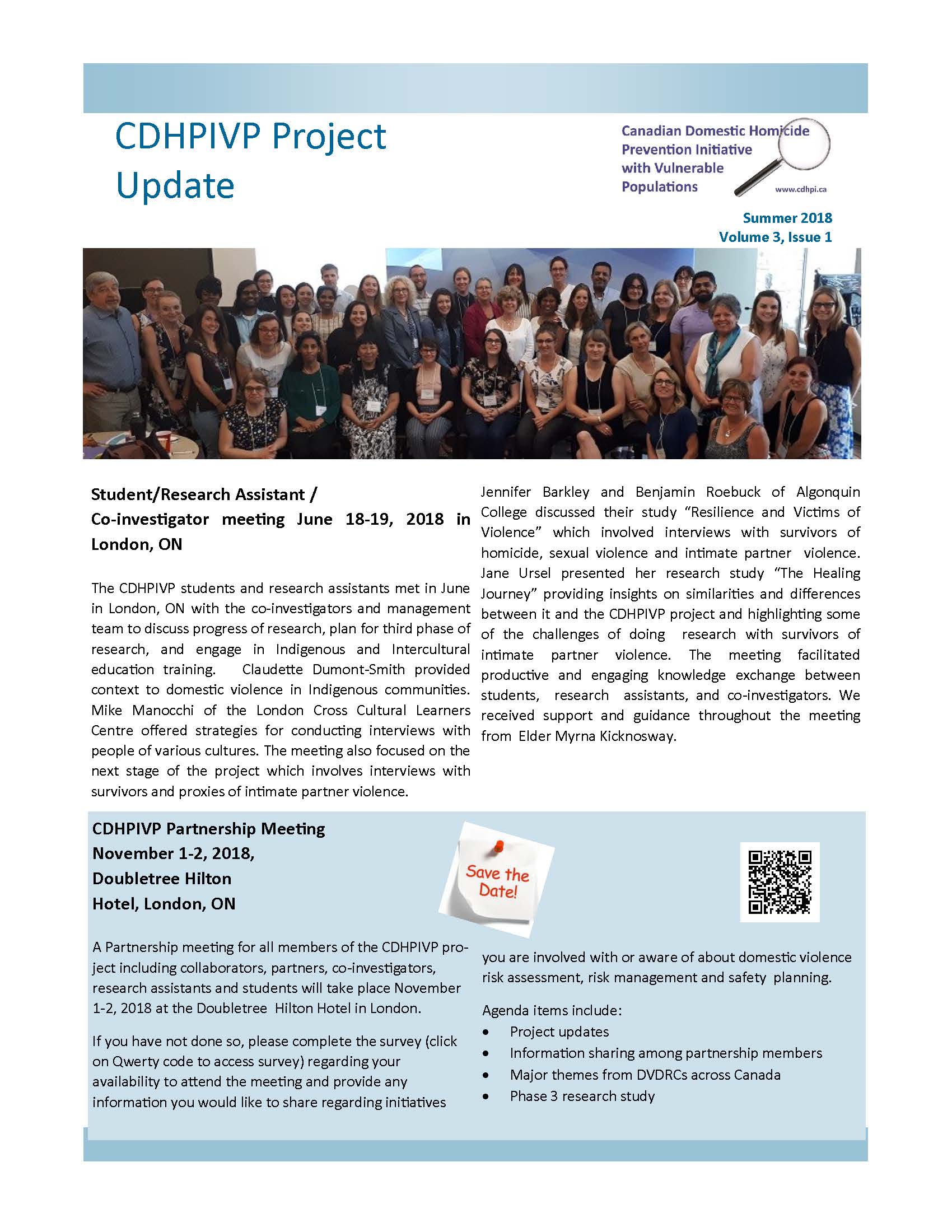 Volume 3, Issue 1 - Summer 2018
Volume 3, Issue 1 - Summer 2018
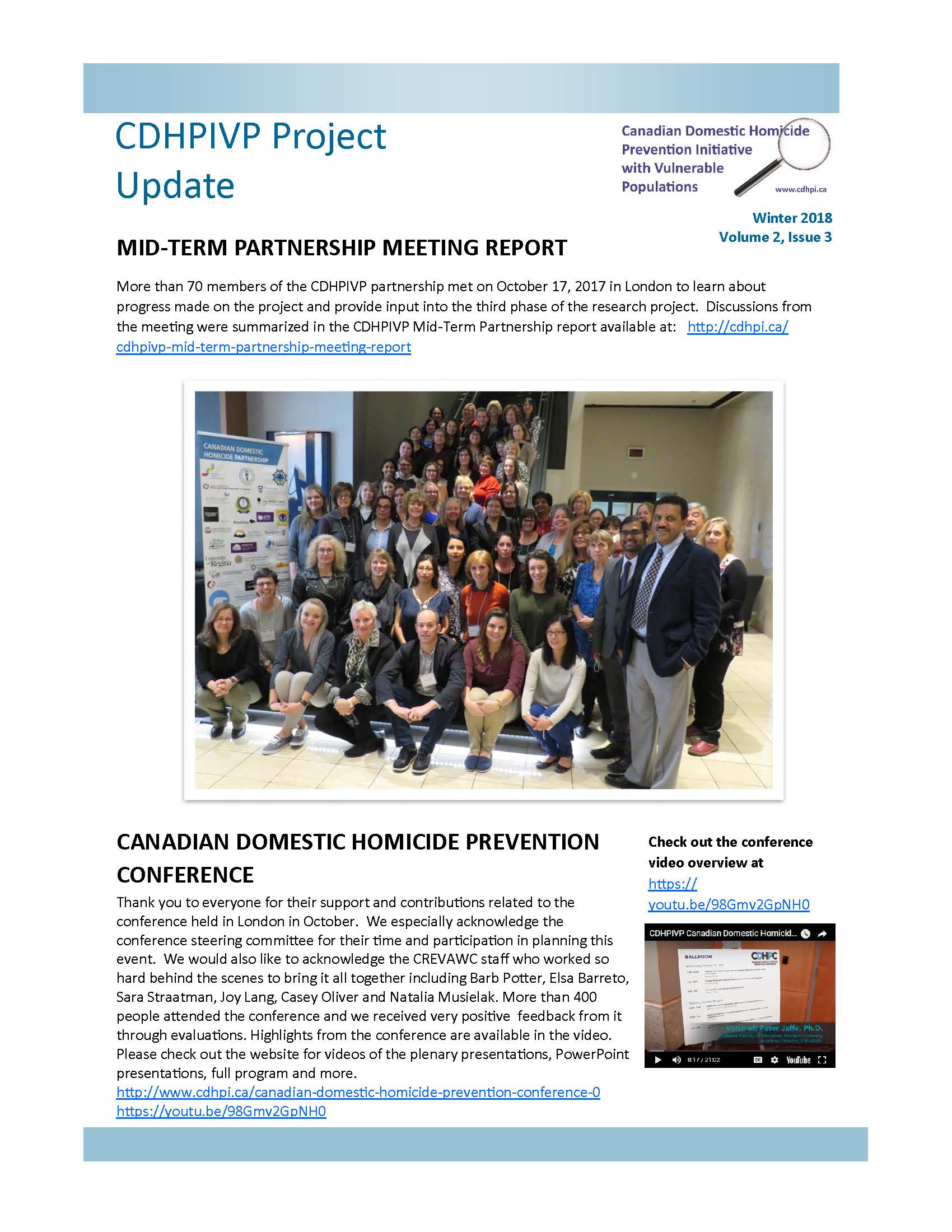 Volume 2, Issue 3 - Winter 2018
Volume 2, Issue 3 - Winter 2018
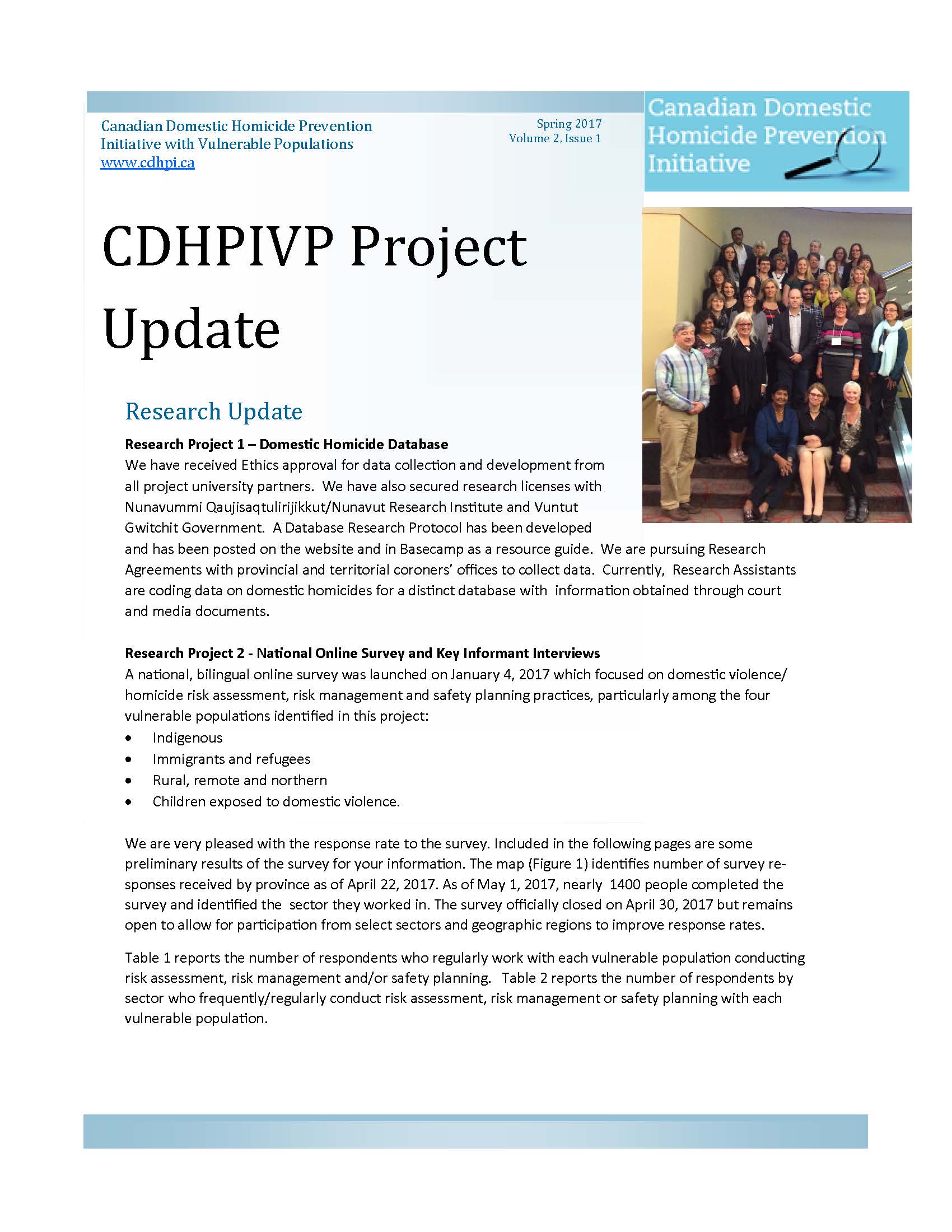 Volume 2, Issue 1 - Spring 2017
Volume 2, Issue 1 - Spring 2017
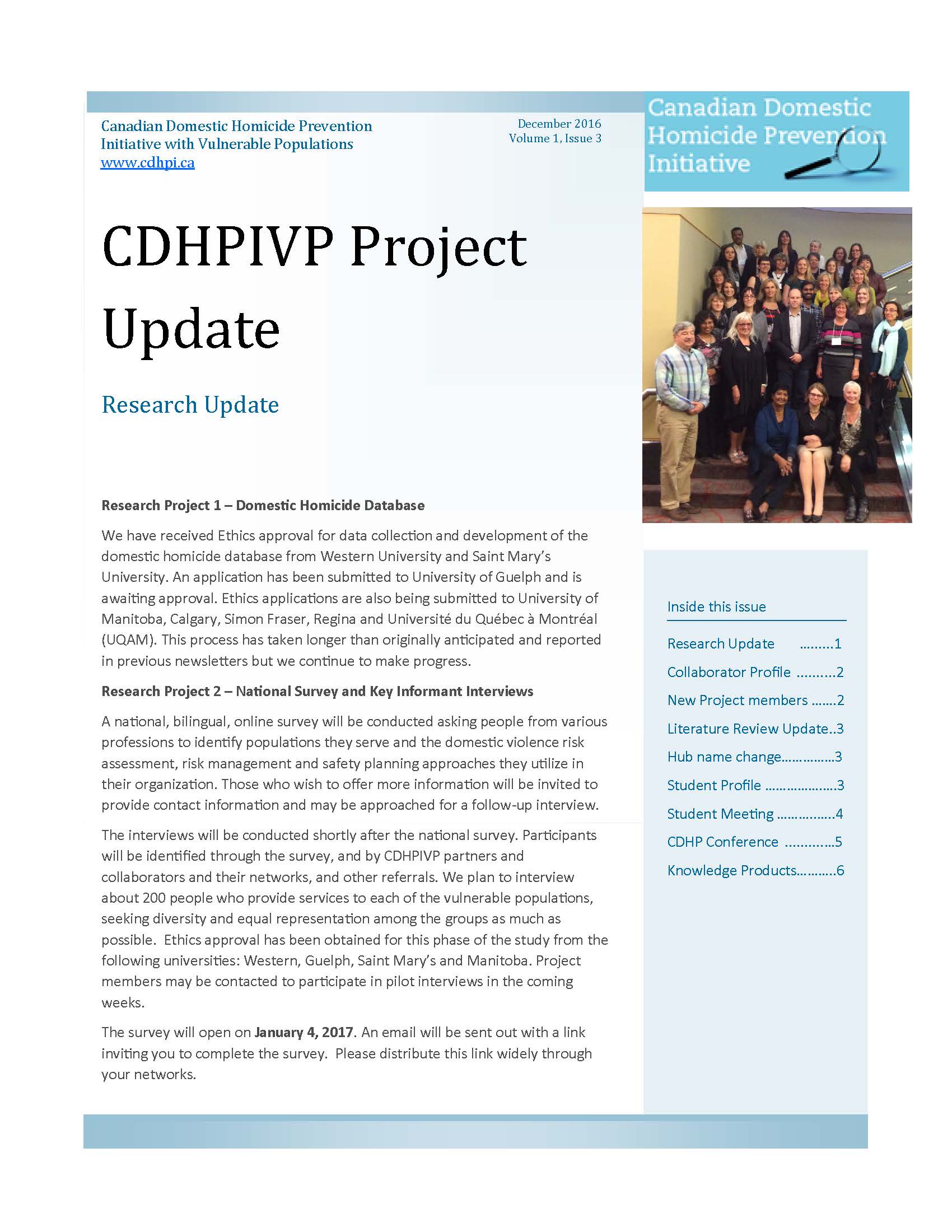 Volume 1, Issue 3 - December 2016
Volume 1, Issue 3 - December 2016
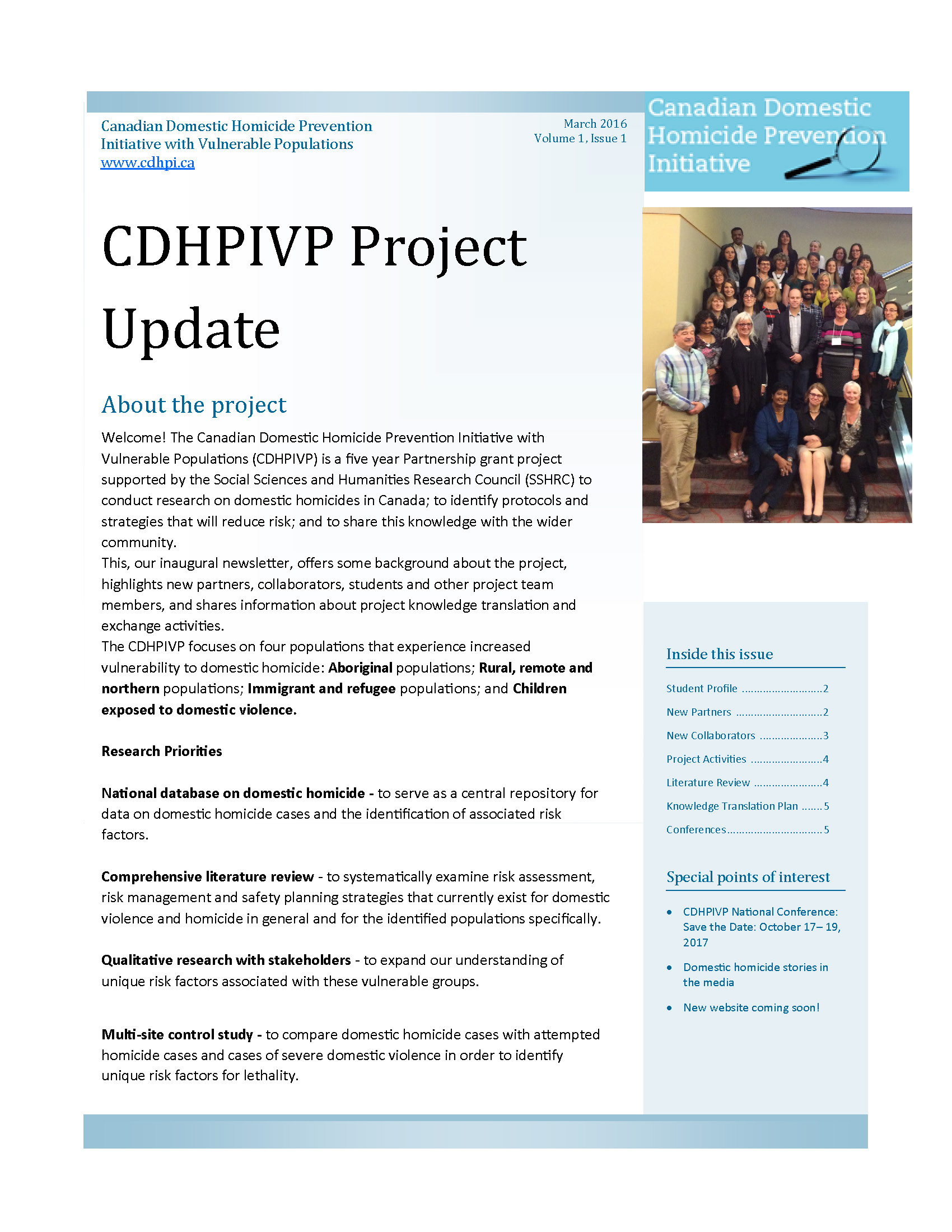 Volume 1, Issue 1 - March 2016
Volume 1, Issue 1 - March 2016
Reports
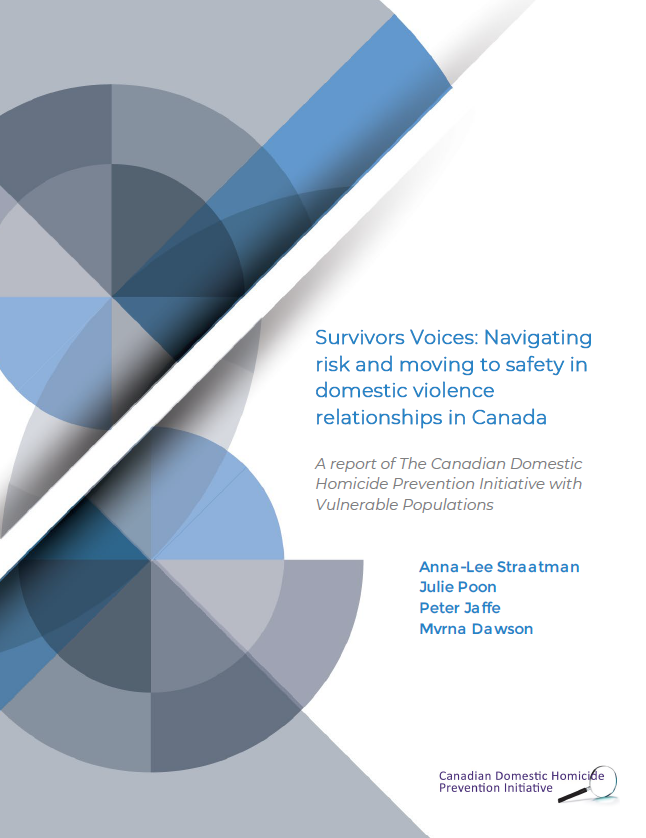 Survivors Voices: Navigating risk and moving to safety in domestic violence relationships in Canada
Survivors Voices: Navigating risk and moving to safety in domestic violence relationships in Canada
This report focuses on research carried out with survivors of domestic violence and loved ones of domestic homicide victims related to risk assessment and safety planning. It provides an overview of key themes that have been identified related to 4 populations: Indigenous, rural, remote & northern; Immigrants & refugees; and children exposed to domestic violence.
This report summarizes research conducted by the Canadian Domestic Homicide Prevention Initiative with Vulnerable Populations with service providers across Canada to gain deeper understanding of potentially unique risk factors, barriers to effective risk assessment, risk management and safety planning, and promising strategies currently being used with these vulnerable groups and the communities in which they live.
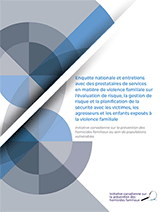 Enquête nationale et entretiens avec des prestataires de services en matière de violence familiale sur l'évaluation de risque, la gestion de risque et la planification de la sécurité avec les victimes, les agresseurs et les enfants exposés à la violence familiale
Enquête nationale et entretiens avec des prestataires de services en matière de violence familiale sur l'évaluation de risque, la gestion de risque et la planification de la sécurité avec les victimes, les agresseurs et les enfants exposés à la violence familiale
Ce rapport résume les recherches menées par L'Initiative canadienne sur la prévention des homicides familiaux au sein de populations vulnérables (ICPHFPV) avec des professionels des différents domaines de la violence familiale, de mieux comprendre les facteurs de risque potentiellement distincts, les obstacles à une évaluation de risque, à une gestion de risque et à une planification de la sécurité efficaces et, enfin, les stratégies prometteuses actuellement utilisées avec ces groupes vulnérables et les communautés dans lesquelles ils vivent.
One is too many: 10 Years Of Domestic Homicides In Canada
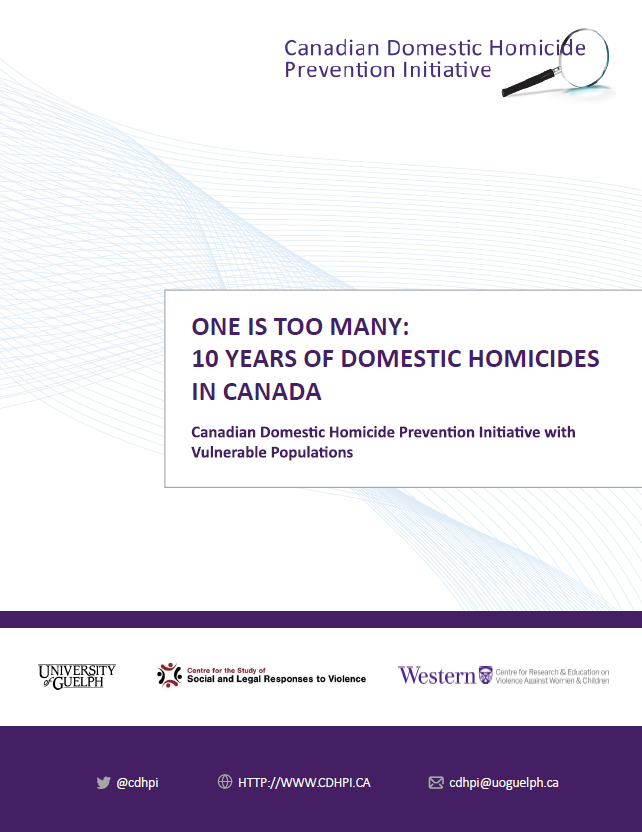 This study documents the number of domestic homicides in Canada between 2010 and 2019 based on court and media reports. This research was conducted as part of a multi-year, SSHRC-funded project entitled The Canadian Domestic Homicide Prevention Initiative with Vulnerable Populations (CDHPIVP; 2015-2021). The project involves academic and community partners across Canada who are focused on promoting collaborative, multi-sectoral research to identify unique individual, community and societal level risk factors that may increase exposure to domestic violence and domestic homicide for specific populations.
This study documents the number of domestic homicides in Canada between 2010 and 2019 based on court and media reports. This research was conducted as part of a multi-year, SSHRC-funded project entitled The Canadian Domestic Homicide Prevention Initiative with Vulnerable Populations (CDHPIVP; 2015-2021). The project involves academic and community partners across Canada who are focused on promoting collaborative, multi-sectoral research to identify unique individual, community and societal level risk factors that may increase exposure to domestic violence and domestic homicide for specific populations.
View ENGLISH PDF Report
View FRENCH PDF Report
One is too many: Trends and Patterns in Domestic Homicides in Canada 2010-2015
This report documents the number of domestic homicides in Canada between 2010 and 2015 based on court and media reports and focuses on four vulnerable populations (Indigenous; rural, remote and northern; immigrant and refugee; children killed in the context of domestic violence) that appear to be at greater risk of domestic homicide due to historical oppression and/or lack of resources because of isolation through factors such as geography, language, culture, age and poverty.
View ENGLISH PDF Report
View FRENCH PDF Report
Canadian Domestic Homicide Prevention Conference 2017 Report
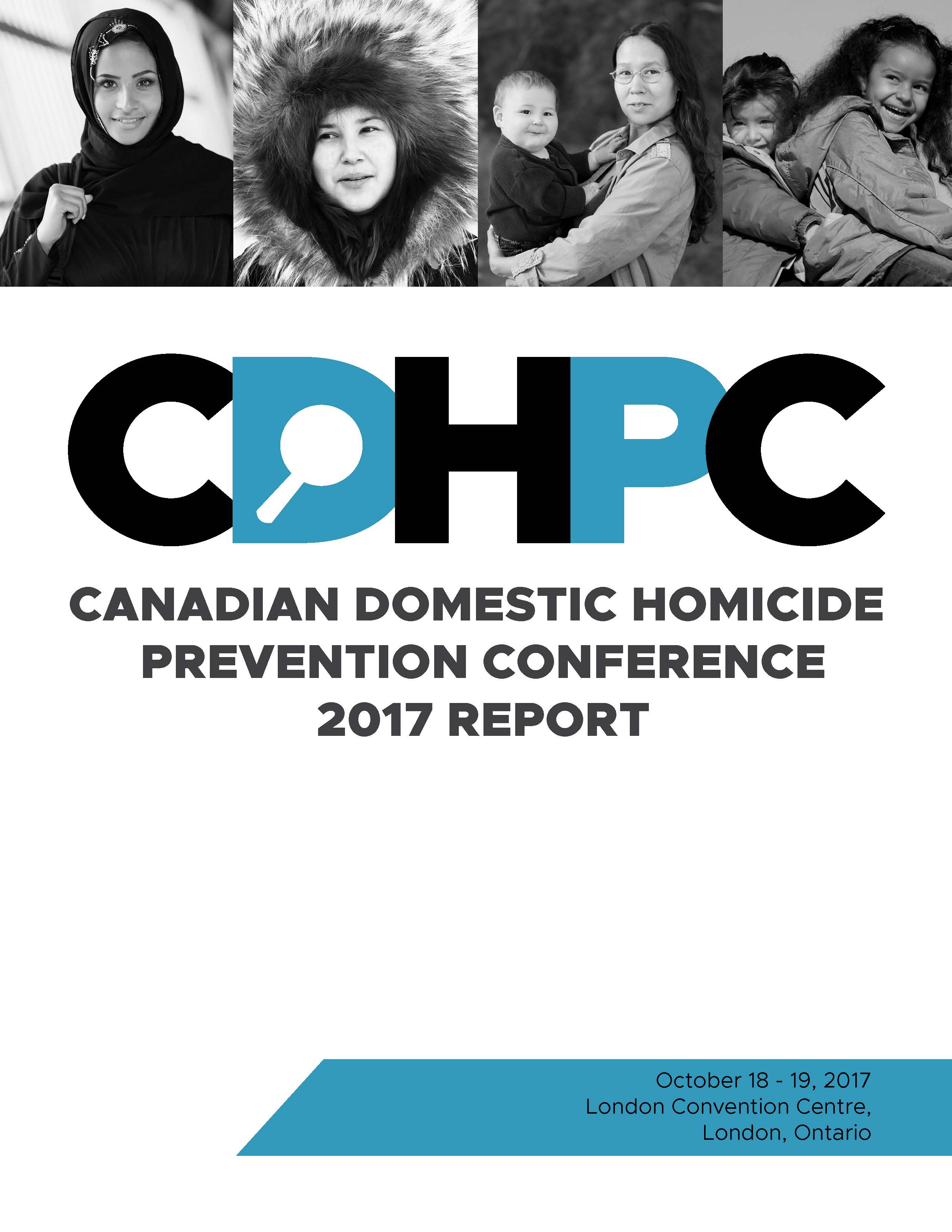 This report highlights presentations and activities from a national conference on domestic homicide prevention which took place October 18-19, 2017 in London, ON.
This report highlights presentations and activities from a national conference on domestic homicide prevention which took place October 18-19, 2017 in London, ON.
View PDF Report Version
View Webpage Version
CDHPIVP Mid-Term Partnership Meeting report
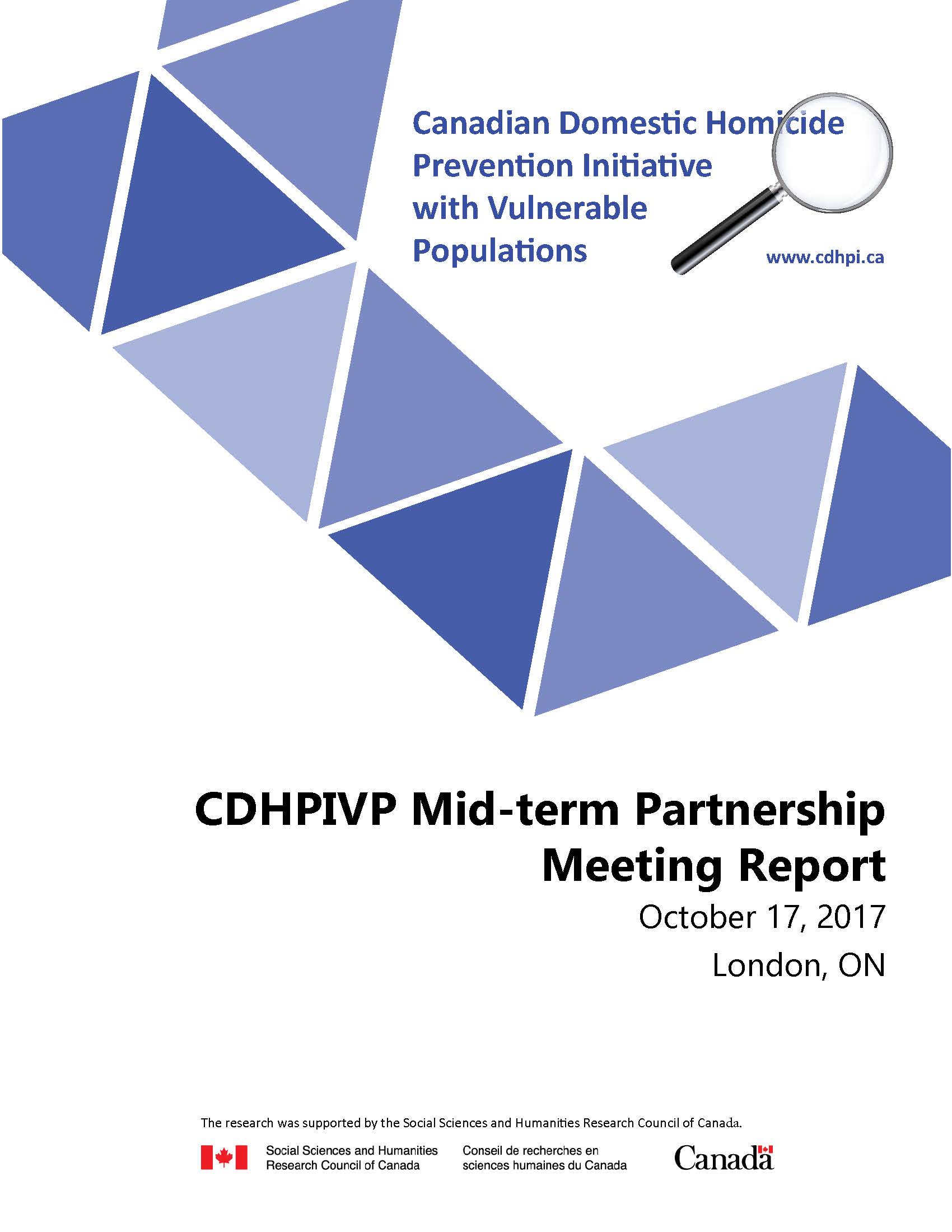 A CDHPIVP Partnership meeting was held in London, ON, October 17, 2017 prior to the Canadian Domestic Homicide Prevention conference. This meeting provided an update to CDHPIVP members on work completed to date, sought input on effectiveness of the partnership and research activities. This report provides an overview of the Partnership meeting presentations, discussion and partnership evaluation.
A CDHPIVP Partnership meeting was held in London, ON, October 17, 2017 prior to the Canadian Domestic Homicide Prevention conference. This meeting provided an update to CDHPIVP members on work completed to date, sought input on effectiveness of the partnership and research activities. This report provides an overview of the Partnership meeting presentations, discussion and partnership evaluation.
View PDF Report Version
View Webpage Version
Research Protocols
Database Research Protocol
The Canadian Domestic Homicide Database will document the total population of domestic violence homicides that occurred across Canada from 2010 to 2020, including sex and age of the victim and the accused, type of intimate relationship (e.g. legal spouses, dating), location and cause of death, province/region. It will also seek to collect information from a variety of sources (e.g. Coroner’s files, domestic violence death reviews, court documents, media reports) pertaining to the circumstances of the homicide, victim and accused profiles, identified risk factors, and criminal justice outcomes. This protocol identifies how data will be collected, stored and used.
Key Informant Interview Protocol
This Protocol was developed to support Research Assistants of the Canadian Domestic Homicide Prevention Initiative with Vulnerable Populations (CDHPIVP) in conducting research interviews with key informants. The objective of the interviews is to ask key informants about their knowledge and use of risk assessment, risk management and safety planning strategies and tools with clients experiencing domestic violence. A focus of the interview is to identify unique risk factors, barriers to effective risk management and safety planning, and strategies currently being used with four populations identified as experiencing increased vulnerability for domestic homicide: Indigenous people; rural, remote and northern communities; immigrants and refugees; and children exposed to domestic violence.
Protocol for Submission and Handling of Knowledge Mobilization Activities
This knowledge mobilization protocol was developed to assist with monitoring and tracking of knowledge mobilization activities for the CDHPIVP project. The protocol is applicable to all members of the CDHPIVP when producing knowledge with information and/or data related to the project.
Phase 3 Survivor Interview Guide
This interview guide was developed using trauma-informed principles to conduct interviews with people who had experienced severe domestic violence. Participants were given the opportunity to share experiences of domestic violence as it related to their help-seeking, risk assessment, and risk management experiences.
Phase 3 Proxy Interview Guide
The Proxy interview guide was utilized with people who were close to a person who were victims of domestic homicide. The participants shared their knowledge of what the deceased person experienced related to domestic violence, help-seeking, risk assessment and risk management.
Infographics
Infographic Series (English):
- General: Trends and Patterns in Domestic Homicides in Canada 2010-2018
- Children: Trends and Patterns in Domestic Homicides in Canada 2010-2018
- Immigrant and Refugee Populations: Trends and Patterns in Domestic Homicides in Canada 2010-2018
- Indigenous Populations: Trends and Patterns in Domestic Homicides in Canada 2010-2018
- Rural, Remote and Northern Populations: Trends and Patterns in Domestic Homicides in Canada 2010-2018
Infographic Series (French):
- General : Tendances et Caractéristiques des Homicides Familiaux au Canada 2010-2018
- Enfants : Tendances et Caractéristiques des Homicides Familiaux au Canada 2010-2018
- Immigrant(e)s et réfugié(e)s : Tendances et Caractéristiques des Homicides Familiaux au Canada 2010-2018
- Autochtones : Tendances et Caractéristiques des Homicides Familiaux au Canada 2010-2018
- Collectivités rurales, éloignées et du Nord : Tendances et Caractéristiques des Homicides Familiaux au Canada 2010-2018




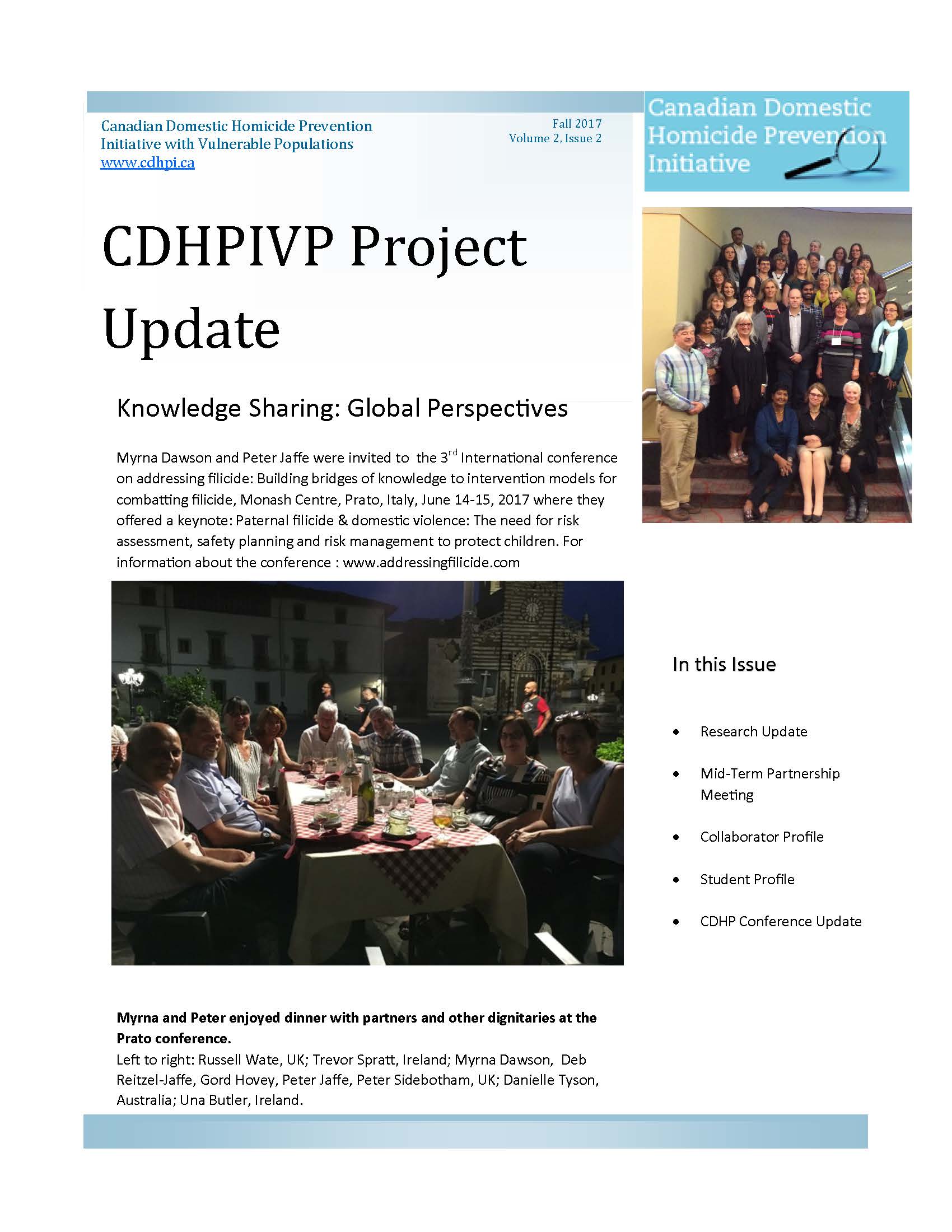 Volume 2, Issue 2 - Fall 2017
Volume 2, Issue 2 - Fall 2017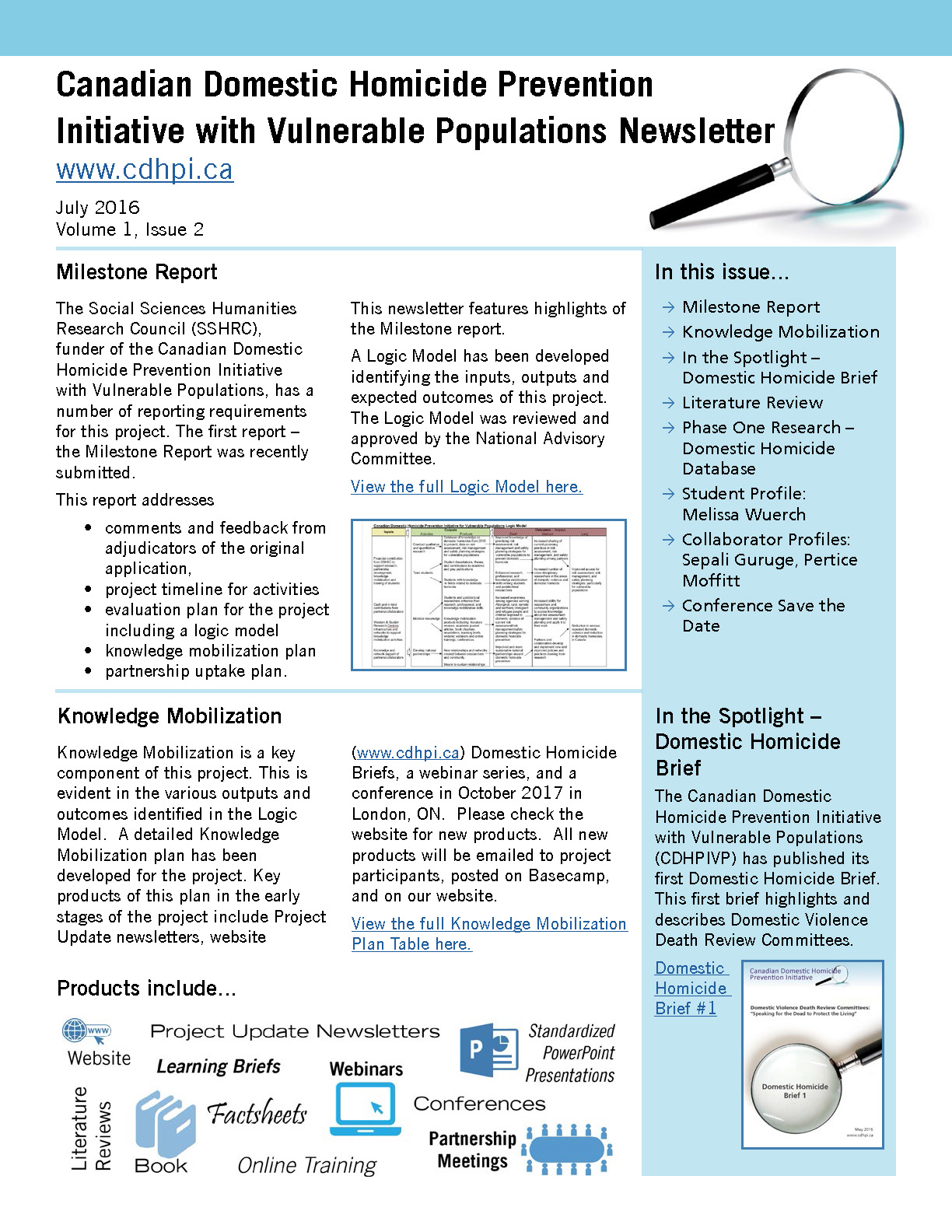 Volume 1, Issue 2 - July 2016
Volume 1, Issue 2 - July 2016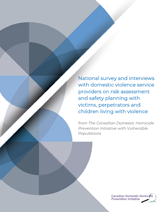 National survey and interviews with domestic violence service providers on risk assessment and safety planning with victims, perpetrators and children living with domestic violence
National survey and interviews with domestic violence service providers on risk assessment and safety planning with victims, perpetrators and children living with domestic violence